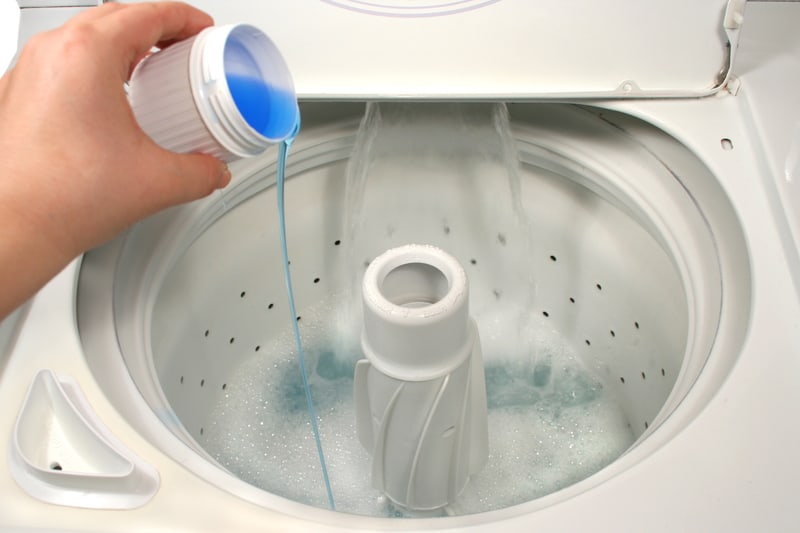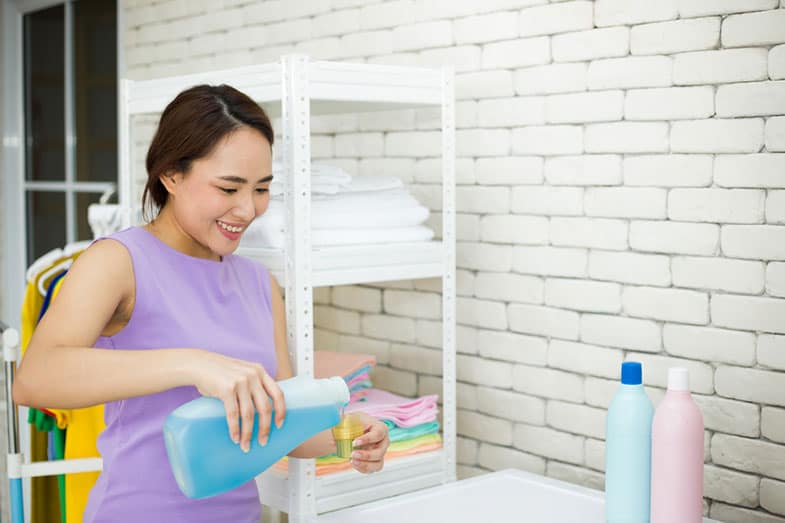Your laundry results revolve around the liquid laundry detergent you use and how you use it. Minor mistakes can lead to significant inconveniences that can be pretty frustrating.
No one can claim that they know how to wash clothes properly. Even after doing it for years, people continue to make many mistakes. For instance, there is a separate slot for adding laundry detergent in the washing machine, but most people still pour the detergent into the drum to save time, ruining the clothes.
However, the clothes will come out cleaner and fresher if the same detergent is added to the detergent slot, as the whole mechanism is designed in such a way as to supply the detergent to the drum at the appropriate time.
This article is a complete guide to using liquid laundry detergent, how to measure it, where to add it, and using dosing balls. Stick to the end to get a lot of insight into using liquid detergent.
How to Use Liquid Detergent
Liquid detergent is a choice of so many. Though different detergent forms are not that different, they still impact the clothes and washing machines. Liquid detergents are a safer choice for automatic washing machines.
It is also better at pretreating stains since you do not have to make a paste separately, like powder detergent. For greasy stains, it does the best work. For stubborn and tough stains, liquid detergent should be your first choice.
Other than that, liquid detergents are also gentler on colored clothes. Also, with this, you can have a better solution for stains and spots. The brightness of colored clothes can never be compromised with it.
Whatever type of detergent you choose, the secret to cleaning clothes lies in the amount of detergent you add. Though selecting the detergent according to your needs is necessary, the measurement equally matters. This blog post will be about using and measuring liquid detergent.
Why is it Necessary to Measure the Detergent?
Measuring liquid detergent or any other type is necessary before adding it to the washing machine. The detergent you add depends on your laundry in the washing machine.
Detergents of different brands are created differently. If you usually add a cup full of detergent for a smaller load of laundry of a brand, you cannot expect it to go the same way for another brand of laundry detergent. You might need a cup and a half for the smaller load of laundry in this case.
This is why it is necessary to read the directions on the pack to get an idea of how much detergent you should use.
Consequences of Adding More or Less than the Needed Amount of Detergent
Adding the right amount of liquid detergent is as important as putting it in the right place. The amount of detergent will determine how well your clothes get washed. Adding more or less detergent might damage or ruin your clothes. Here is how it works.
When you add detergent to the washing, it leads to the formation of suds. Adding more detergent means more formation of suds. When suds remain in the washing machine for a longer time, it is likely to damage the part of the washing machine. Although these suds damage every type of washer, the likelihood of the high-efficiency device getting hurt is higher.
Using more detergent and damage due to it is a user error. When the electronic parts of a washing machine get damaged due to suds, the warranty of the washing machine becomes void.
Other than that, using more than the needed amount of detergent leaves many detergent residues on the clothes. The clothes look dull, and several different types of stains start appearing on the clothes. The clothes also carry the strong smell of detergent.
On the other hand, not using enough detergent will result in poorly cleaned clothes. These clothes will give out a foul smell and look even dirtier after washing.
Adding Detergent on the Top of Clothes
Detergent is never meant to be put on the top of clothes. There are so many cons to doing so.
When you add detergent on the top of clothes, it accumulates at specific parts of your clothes, leaving different stains and spots on the clothes. Other than that, the detergent does not dissolve effectively in the water. This is because the detergent does not get enough space to get mixed up with the clothes inside, acting as a barrier.
This unequal dissolvent of detergent leaves a film on the clothes that quickly fades their color.
If you mistakenly poured the detergent on the clothes, washing them away as soon as possible is recommended. The stains and spots are washable and get off quickly when fresh. However, when they stay on the clothes for a longer time, it becomes almost impossible to remove them.
Read More: Do You Pour Liquid Detergent on Clothes?
Using Liquid Detergent in a Front-load Washing Machine
Front-load washing machines have been in the limelight for the past few decades. Since front-load washing machines conserve energy and use less water than other washing machines, people nowadays are more attracted to them.
High-efficiency Washing Machines
High-efficiency washing machines hit the market in the 1990s. From the very beginning, high-efficiency washing machines came in the front-load form. This means that the front-load washing machine can be both regular and high-efficiency.
High-efficiency washers need extra care and attention. Firstly, separate types of detergents are available for these washing machines. The detergents come in different forms, i.e., liquid, powder, etc. These detergents are prepared such that they are compatible with high-efficiency washers.
Even using such detergents requires extra care and attention while measuring them. If the detergent exceeds the average amount, many suds will overflow the machine, damaging its system and voiding the warranty.
Read More: Does Liquid Detergent Damage Washing Machines?
Parts of Front-load Washing Machines

That was all about the high-efficiency washing machines. In general, front-load washers have similar compartments, even of different brands.
There is a drawer on the top bar of the washing machine. Inside this drawer, you will find three more compartments. Each is used for detergent, fabric softener, and liquid bleach. From the label, it is obvious why you should use each of these.
Measure the correct detergent amount. You can use the bottle cap or any other measuring cup. Here are the accurate measurements that might be helpful for you.
- For regular load – 1 tablespoon of laundry detergent
- For heavy loads – 2 tablespoons of laundry detergent
Never add the detergent without measuring it first. Once you are done measuring, pour the detergent into the right detergent compartment of the washing machine. Close the drawer and begin the regular wash cycle.
The front-load washing machine with such separate compartments is made to consume the detergent automatically during the cycle. You must initiate the process properly; the rest is up to the washing machine.
Using Liquid Detergent in a Top-load Washing Machine

Boomers find top-load washing machines more attractive due to fewer knobs and ease of operation. Top-load washing machines were a thing of the past. Today, people are attracted more towards front-load washing machines.
But in no way does it mean that top-load washing machines are not in demand. They are. These machines are an excellent choice for older people and those with back pains. However, you cannot use its top as a table as you can do with the front-load washing machines.
Read More: Where Do I Put Laundry Detergent? (Front-Loader/Top-Loader)
Parts of Top-load Washing Machines
Unlike front-load washing machines, there are no separate compartments for adding laundry products. This is why we must pick a more suitable alternative to add laundry products to the washing machine.
Add Detergent to the Washing Machine
Since we do not have separate compartments for each laundry product, we need to pour everything into the drum of the washing machine. Begin by adding water to the washing machine. Once it reaches the required amount, please turn off the tap and add the liquid detergent after measuring it.
Mix the detergent with water well. Once it is done, add the clothes. Do this step crucially, and always add the detergent after the water just before adding the clothes. This is because when you add the detergent on the top of clothes, it does not mix well in water and leaves stains.
Similarly, you can pour other items like bleach and fabric softener into the washing machine. However, ensure that you add the fabric softener in the rinse cycle rather than in the wash cycle. The Wash cycle of many washing machines is strong enough to remove the fabric softener’s chemicals, leaving no effect on the clothes.
Therefore, a better approach is to pour the fabric softener into the rinse cycle to give softness to the clothes you need.
Dosing Balls for Liquid Detergent
Though the cap of liquid detergent is used for measuring it, it is pretty big and does not guide well in most cases. The solution to this problem is to get the measuring tools for your laundry. In the case of liquid detergent, dosing balls will do the job just perfectly.
Detergent pods are not much of an issue since they are already measured. Powder detergents need powder scoops for the correct measurement. While for liquid detergent, dosing balls are the perfect option. But what are the dosing balls?
Dosing Balls
As the name suggests, dosing balls are round, just like a ball usually made of plastic material. Typically, dosing balls have a capacity of 35 ml, which may vary depending on the brand you purchase. Dosing balls help you measure the detergent accurately, so forget about wasting detergent or getting dirty, uncleaned clothes.
Dosing balls are versatile and can be used in any washing machine. Whether top or front-load, you can enjoy its service in these washing machines.
How to Use it?
Open the dosing ball and fill it with detergent, depending on the load of laundry. Close it and then pop it in the washing machine. For the front pack, make sure you pop it at the back. While for the top-load washing machines, a good practice is to pop it at the bottom. This practice helps in detergent reaching all of the washing machines.
After putting it in the washing machine, start the wash cycle and let the dosing ball do its job.
Also, dosing balls can be used to handwash several clothes. You can also use it as a measuring device to measure the detergent whenever you need to wash the clothes. In 5 liters of water, you can mix 17 ml of liquid detergent by measuring it using a dosing ball.
In Conclusion
Just like people prefer front-load washing machines to top-load ones, people are inclined towards liquid laundry detergent rather than powdered ones. Since liquid detergents are suitable for automatic washing machines and are gentler on the clothes, they are a win-win.
Front-load washing machines almost always come with separate compartments for the detergent, where you can quickly pour the detergent just before starting the wash cycle. No such chambers exist for top-load washers, so you must run the detergent directly into the washing machine.
For the correct measurement, you have a dosing ball that serves its purpose just fine. It is a must-have at home. If you still have not purchased it, what are you waiting for? Grab it right away.

